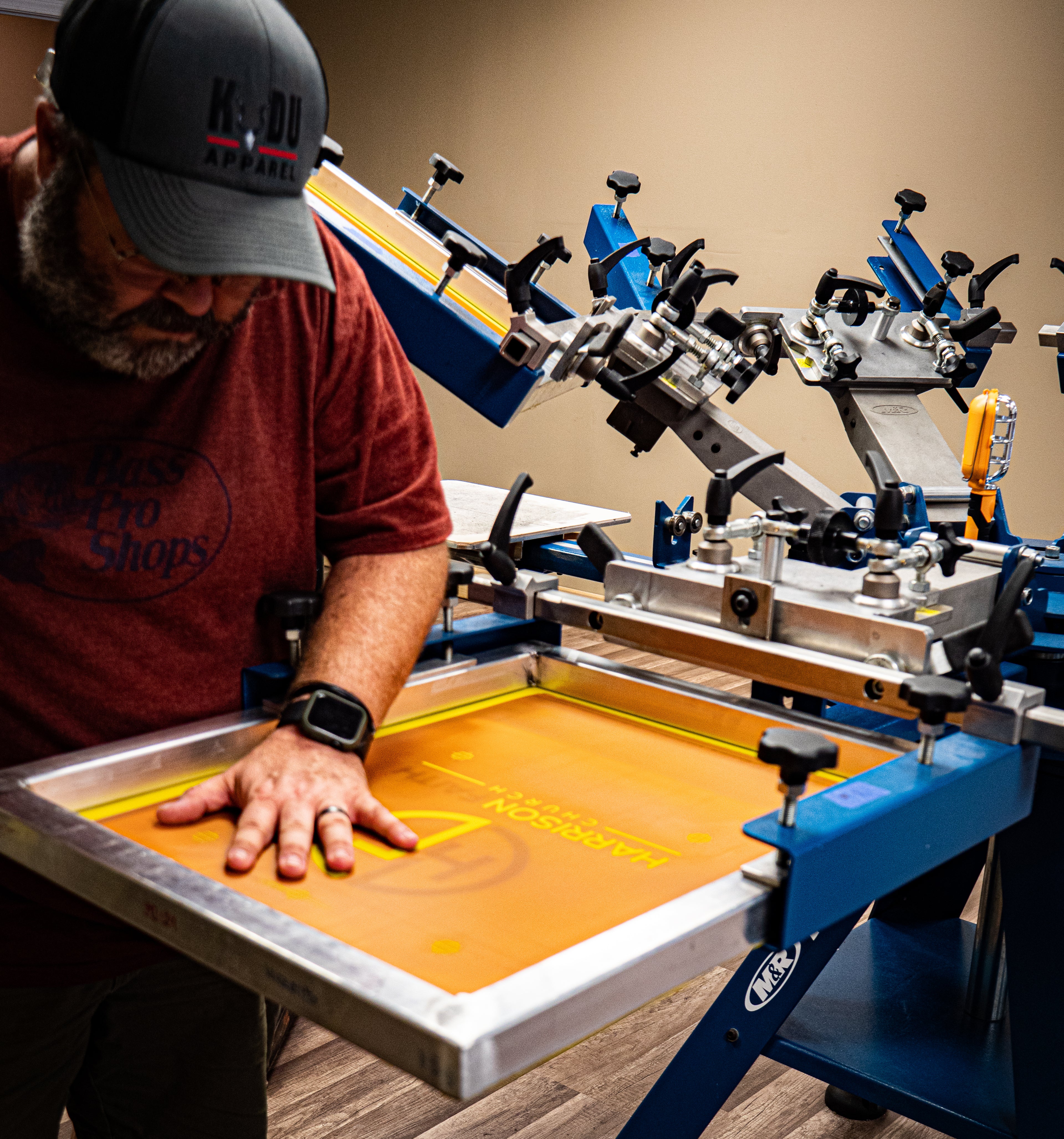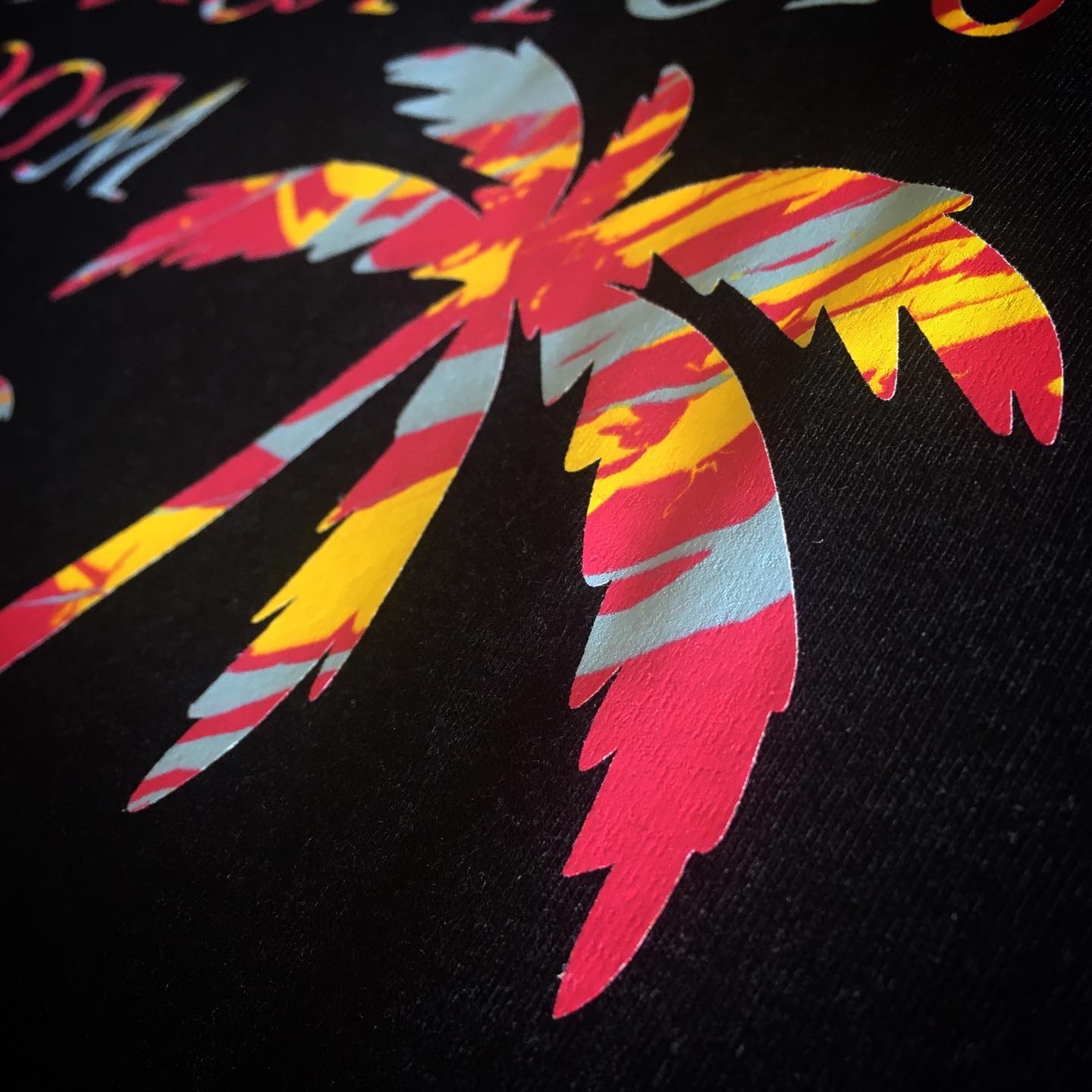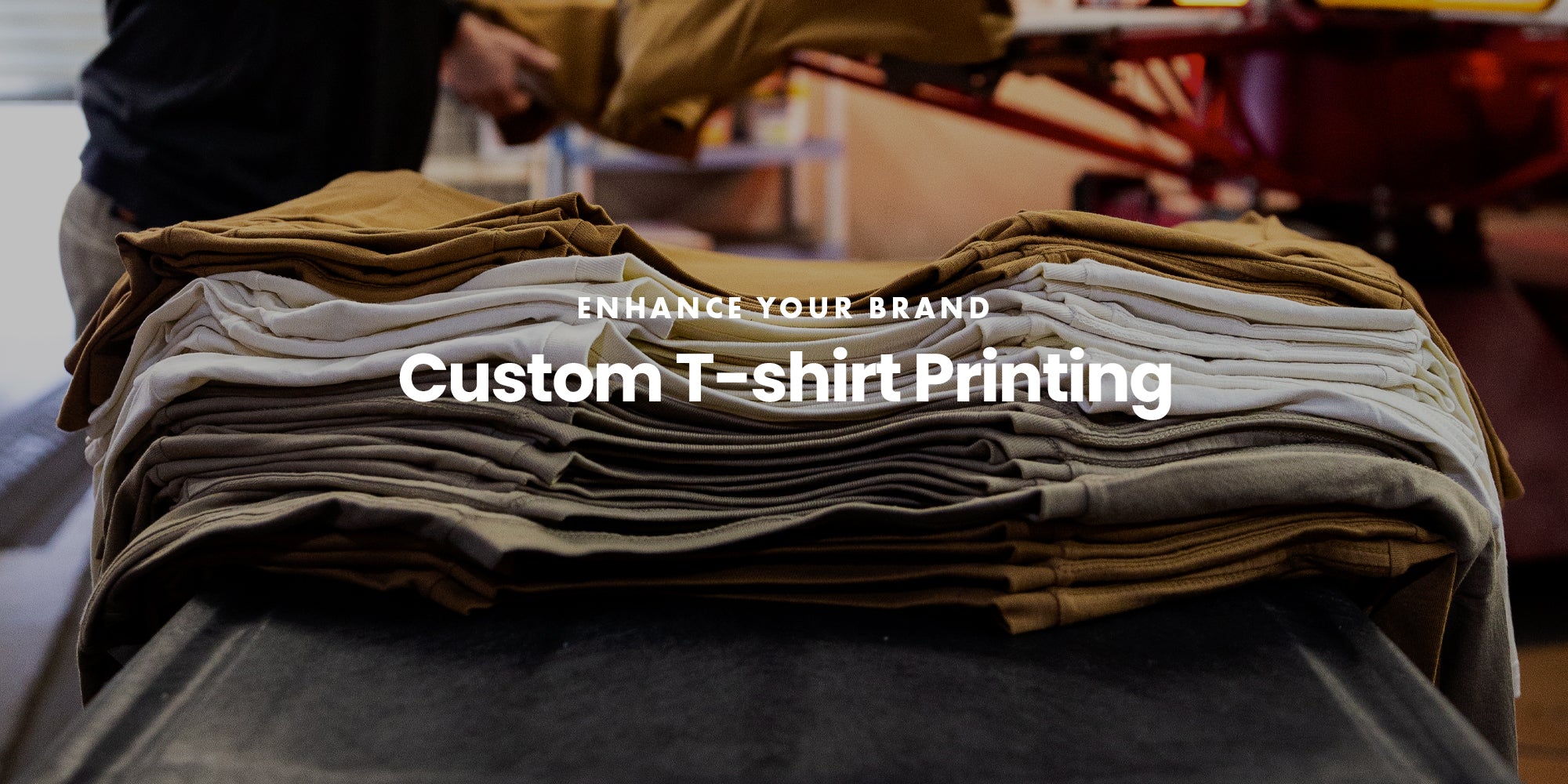High-Quality Custom Screen Printing for Team Apparel
High-Quality Custom Screen Printing for Team Apparel
Blog Article
Display Printing Uncovered: Every Little Thing You Required to Understand About Tee and Garment Printing Techniques
Display printing is a fascinating method that incorporates art with strategy, supplying unlimited possibilities for creative thinking. All set to explore the vital aspects that make screen publishing an art type?
The Basics of Screen Printing: Just How It Works
When you dive into screen printing, you'll find it's both a scientific research and an art. At its core, display printing entails producing a stencil, or display, that allows ink to pass via only in certain areas.
Next, you'll blend your inks and prepare your printing surface area. Placement the display over the material, then make use of a squeegee to push ink via the screen onto the garment. This procedure requires accuracy, as you want clear, dynamic prints. After printing, you'll heal the ink with warm, ensuring it abides by the fabric and lasts through laundries. Each step is crucial, and mastering them will certainly raise your display printing skills, transforming basic garments right into unique, meaningful pieces.
Types of Display Printing Strategies
Once you comprehend the fundamentals of display printing, it's time to discover the various methods that can raise your styles. One prominent technique is standard display printing, where ink is pressed with a stenciled screen. This method is great for vibrant, vivid colors. Then there's water-based ink printing, which offers a softer feeling and is green, but it needs a various approach to healing.
If you're going for great information, think about discharge printing. This technique gets rid of color from the material, leaving a soft, classic look. Another option is plastisol printing, understood for its resilience and brilliant shades, making it a favored for several brands. Lastly, experiment with halftone printing to produce slope results and complex styles. Each method has its unique beauty, so don't wait to attempt them out to find what suits your design best!
Crucial Equipment for Display Printing
To achieve sensational results in display printing, having the appropriate equipment is basic. You'll need a tough screen printing structure, which holds the mesh that transfers your design onto the garment. Next, spend in premium squeegees; these are crucial for applying ink uniformly throughout the screen. You'll also require a good exposure unit to develop your displays, in addition to a washout cubicle for cleaning them after usage. A trustworthy warm resource, like a conveyor clothes dryer or warm press, is crucial for treating your prints to ensure long life. Don't fail to remember an appropriate work space, equipped with tables and storage for your materials. Lastly, safety equipment, such as masks and handwear covers, will certainly keep you safe from chemicals and inks. With the right devices, you'll be well on your way to generating professional-quality prints.
Picking the Right Inks and Materials
When choosing inks and products for display printing, you require to take right into account the kind of ink that works finest for your job. Believe concerning fabric compatibility to ensure your layouts look great and last lengthy. Check out eco-friendly ink options to make your printing process more lasting.
Sorts Of Display Inks
Picking the ideal screen ink is necessary for achieving vivid, sturdy prints that meet your task's demands. There are numerous types of screen inks to analyze. Plastisol ink is preferred for its adaptability and simplicity of usage, providing exceptional color opacity on dark textiles. Water-based ink, on the other hand, uses a softer feeling and is green, making it excellent for those wanting to minimize their environmental influence. Release inks eliminate dye from the textile, leading to a soft, classic look yet require particular handling. Specialized inks, such as metallic or glow-in-the-dark, can include special results to your layouts. Examine your task needs and select the ink that straightens finest with your preferred outcome.

Material Compatibility Considerations
Understanding material compatibility is essential for achieving high-grade screen prints, especially because different materials react distinctively to numerous inks. Always check your inks on example material to guarantee they adhere appropriately and maintain shade integrity. In addition, maintain in mind that fabric weight and structure can affect the last result, so choosing the best ink and product combination is vital for your task's success.
Eco-Friendly Ink Options
Environment-friendly inks are coming to be a popular choice for screen printers that want to minimize their environmental influence while preserving quality. When selecting inks, take into consideration water-based inks, which are much less hazardous and less complicated to cleanse up contrasted to typical solvents. These inks bond well with fabrics, supplying vibrant outcomes without harmful chemicals. You might also explore eco-solvent inks that utilize less volatile natural compounds (VOCs), making them a safer choice for both your health and wellness and the earth.
Furthermore, seek inks made from sustainable resources, such as soy or vegetable-based choices. By selecting the ideal inks and materials, you'll not just create sensational layouts however additionally Bonuses add to a more sustainable printing process. Make you can try here the button, and your prints will certainly reflect your commitment to the environment!
Preparing Your Design for Display Printing

Submit Format Demands
To guarantee your style looks sharp and lively on textile, you'll need to pay close attention to file style needs for screen printing. Beginning with vector data like AI or EPS, as they can be scaled without losing top quality. If you make use of raster pictures, go with high-resolution documents, such as TIFF or PNG, preferably at 300 DPI. Avoid utilizing JPEGs, as they can shed quality when resized. Make certain your style has a transparent history to prevent unwanted white sides on your prints. Finally, keep shade modes in mind; CMYK is common for screen printing, so convert your RGB designs as necessary. By following these standards, you'll establish your artwork up for an effective print.
Shade Splitting Up Methods
Shade splitting up is a crucial step in preparing your design for display printing, and mastering it can considerably improve your print quality. You'll need to damage your style into specific colors, as each shade needs a separate screen during printing. Start by determining all the colors in your design and develop layers each. You can use software program like Adobe Photoshop or Illustrator to isolate and separate shades successfully. Be certain to conserve each layer as a separate documents, usually in a layout like TIFF or PSD. This precision not only ensures precise color depiction however also simplifies the printing procedure. By focusing on color splitting up, you'll achieve lively and expert cause your screen-printed garments.
Resolution and Dimension
Attaining the very best lead to screen printing starts with guaranteeing your design has the right resolution and dimension. Ideally, your artwork ought to go to least 300 DPI (dots per inch) for sharp, clear prints. If you utilize reduced resolution, your last product may look amateur and pixelated.
When it concerns size, think about the dimensions of your print area. Layout your art work to match the last print dimension, ideally producing it in the real dimensions you'll be publishing. By doing this, you'll prevent any type of unforeseen scaling issues.
Constantly inspect your design in both vector and raster styles. Vector graphics can be scaled without losing high quality, making them ideal for screen printing. Preparing properly will guarantee your style looks incredible on every garment!
Step-by-Step Display Printing Refine
Screen printing is a dynamic procedure that permits you to create vibrant designs on various surface areas. To get going, you'll need a display, check emulsion, and your selected ink. First, prepare your display by cleaning it thoroughly. Next, apply the solution evenly and allow it dry in a dark location. Once completely dry, subject your screen to light with your layout placed on it, which will certainly solidify the solution where the light hits, creating a pattern - screen printing kit.
Pour ink onto the display and make use of a squeegee to press the ink with the stencil onto the textile. Lift the screen carefully and let the print completely dry. You have actually successfully display printed your design.
Tips for Effective Screen Printing Projects
While you're diving right into your screen printing jobs, keep in mind that preparation is key to success. Start by collecting all your products-- inks, screens, squeegees, and garments. A tidy work space helps protect against undesirable mistakes, so clean up prior to you begin.
Following, validate your artwork is high-resolution and appropriately sized for your garment. Test your display for appropriate exposure and clean it extensively to prevent spots. When blending your inks, follow the producer's guidelines to achieve the right uniformity.
During printing, apply even stress with your squeegee for regular outcomes. Don't rush; take your time to verify each print fulfills your criteria. After printing, allow your garments dry completely before managing or packaging them.
Last but not least, always keep an example of your benefit future referral. By doing this, you can assess your progress and boost your methods in time. Satisfied printing!

Regularly Asked Inquiries
The length of time Does It Require To Establish a Screen Printing Task?
Establishing a display printing work generally takes about 30 mins to an hour. You'll prepare the displays, mix inks, and change the press. The moment varies based upon complexity and experience, so remain arranged!
Can I Print on Various Textile Types Utilizing the Exact Same Strategy?
Yes, you can publish on different textile types making use of the same technique, however you'll require to change your setups and inks. Some textiles soak up ink differently, so exploring guarantees the very best outcomes for each material.
What Are Typical Blunders to Stay Clear Of in Screen Printing?
When display printing, avoid typical mistakes like utilizing the wrong ink, neglecting proper direct exposure times, or avoiding pre-press checks. Constantly evaluate your arrangement and keep tidy screens to assure top quality results each time.
Exactly How Can I Properly Tidy and Maintain My Screen Printing Devices?
To properly clean and maintain your screen printing tools, you should regularly clean displays with suitable solvents, inspect mops for wear, and assure all devices are saved dust-free and dry. Consistency stops costly repairs and improves efficiency.
Is Display Printing Eco-friendly Contrasted to Other Approaches?
Display printing can be much more ecologically friendly than other techniques, especially if you make use of water-based inks and eco-conscious products. By choosing sustainable products and methods, you reduce waste and minimize your influence on the planet.
Screen Printing Uncovered: Whatever You Required to Know About T-Shirt and Garment Printing Methods
At its core, display printing entails creating a stencil, or display, that enables ink to pass via just in details areas. Setting the screen over the fabric, then utilize a squeegee to press ink via the display onto the garment. One popular method is standard screen printing, where ink is pressed through a stenciled display.When choosing inks and products for display printing, you need to take into account the type of ink that works ideal for your project.
Report this page